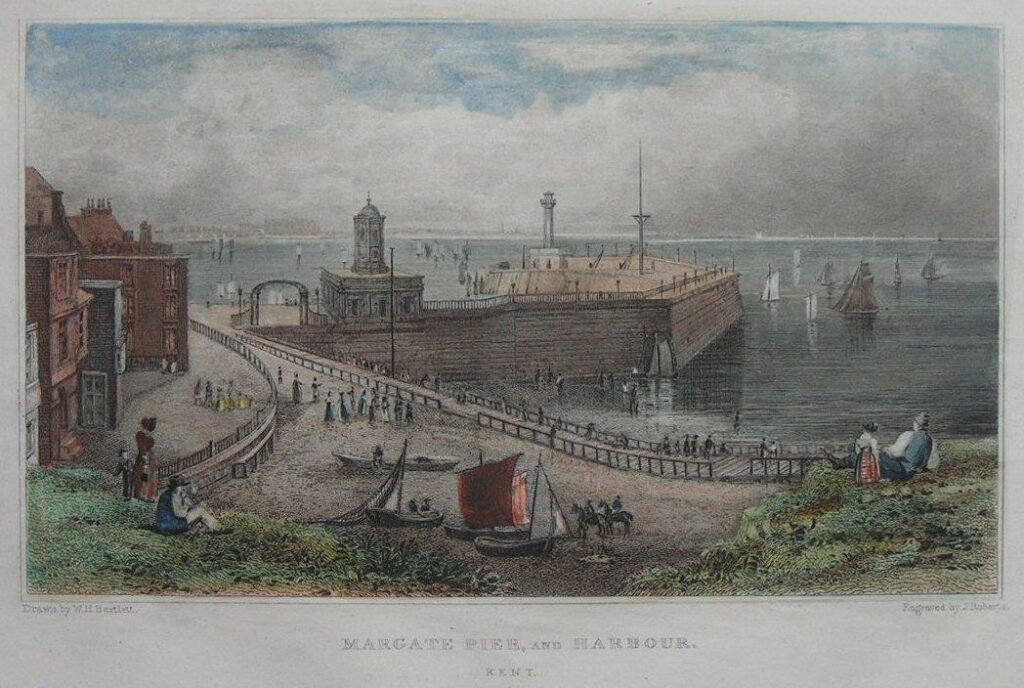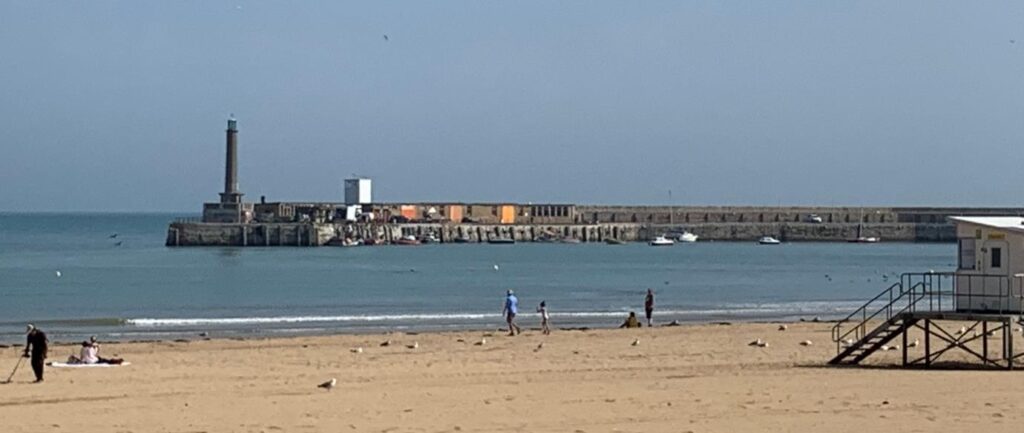The Life and Works of John Rennie (7 June 1761 – 4 October 1821)
Margate Harbour Arm
Sue Threader
Bathing in the sea became popular during the early eighteenth century for both recreation and its perceived medicinal benefits. At this time Margate was a small fishing village but gradually became popular as a fashionable bathing resort with many of the holiday makers arriving by sailing ship from London. A great storm in January 1808 destroyed Margate’s Old Pier.
In 1808 John Rennie was appointed by the harbour trustees and to report on options to replace the structure. He noted that when the wind was blowing from the north or south then the harbour was safe, but that easterly winds created a heavy swell and problems which negotiating sandbanks and rocks “which occasions numberless shipwrecks”. He advised that “To rebuild [the Old] Pier … in its present form would certainly be very injudicious” given that its alignment and the shape of construction “instead of turning the waves from the harbour, turn them into it”.
Rennie proposed to demolish the remains of the Old Pier to within 120 ft. of the jetty and then build a new, straight section to the west for 255 ft. before turning south west for 30ft. then adding a final arm running north-south for a further 135 ft. to create a sheltered harbour from the easterly and westerly winds and reduce the build-up of sand.
Anticipating objections from the users of the harbour and the trustees he did offer an alternative to his recommendation, by which the final section was inclined more to the south west to reduce costs and make entry and exit from the harbour easier but pointed out that the trustees were choosing to “take responsibility upon themselves” by adopting this solution which he pointed out would be “at less expense than the other [solution] but this will not only lessen the shelter but reduce the capacity of the harbour”. This offering of alternatives and understanding the wider issues his clients faced, was a characteristic of Rennie’s approach. In the event it appears his less-preferred solution was constructed.
Rennie’s report contains an interesting explanation of why he usually preferred to build piers and harbour walls as a series of straight sections (known as “kants”), rather than as a smooth curve. Apart from giving an insight into his technical thought-processes, the clear explanation demonstrates his skill at explaining engineering matters to politicians and his lay clients. He wrote:
“Curved Piers are said to be stronger than those formed of straight-lined Kants. This opinion must have arisen from misapprehension. An arch or curve is no doubt better adapted to resist the effect of pressure than a straight wall providing this pressure were always to act in the direction of the radius of curvation [i.e. the force is perpendicular to the face of the wall] but as this cannot be the case – it will be found weaker than a straight-lined pier – for on those parts where the waves act obliquely they have a tendency to pull the stones out of the pier”.
To construct a pier in the shape of a convex curve, the side of each stone on the outer face needs to be longer than the side buried within the pier itself and Rennie pointed out that “less force will be needed to pull them out – besides, when a wave strikes a curved pier it is led gently along it and accumulates in strength as it proceeds, whereas when acting on Kants the direction given to it by the one Kant tends to cross the direction given by the other, and thus instead of an accumulated power it is diminished.”
On the basis of Rennie’s report, an Act of Parliament was obtained and John Rennie was appointed to complete designs and construct a replacement at a cost of £ 60,000. The new Harbour Arm with the first lighthouse was erected in 1815 and a month later the first of many regular steamboats arrived bringing Londoners to visit the elegant squares and fashionable hotels which were established as the resort became more popular as a result. The structure incorporated a promenade so visitors could enjoy the views of the sea without getting in the way of the steamboat operations. The new harbour meant that freight steamers could also come into Margate and it became a busy commercial port.

Serious problems were encountered during the construction of the stone pier due to freshwater springs that undermined a 100 yard stretch of the wall. The problem was overcome by creating timber raft foundations on a clay bed with the stone walls built up on top. The internal structure of the wall was a series of compartments filled with rubble and shingle while the harbour wall itself was faced with stone recovered from a demolished church at nearby Reculver, some larger blocks from the old pier and the remainder was quarried from Whitby in Yorkshire.

References:
Report by John Rennie to the Trustees of Margate Harbour, London, 30 July 1808
http://www.margate.org.uk/margate-harbour-circa-1840.php – Mayor and Charter Trustees of Margate

